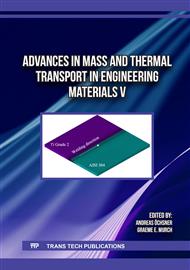[1]
Magdassi. (1999). Advanced topics in printing techniques. Retrieved May 20, 2024, from https://piams.org/inkjet-printing-technologies/
Google Scholar
[2]
Rapp, B. E. (2016). Microfluidics: Modeling, mechanics and mathematics (p.1–766). Elsevier
DOI: 10.1016/C2012-0-02230-2
Google Scholar
[3]
Rivas, D. F. (2008). Microfluidos: ¿cuánto hay de nuevo? Divulgación-Física.
Google Scholar
[4]
Crane, N. B., Onen, O., Carballo, J., Ni, Q., & Guldiken, R. Fluidic assembly at the microscale: Progress and prospects. Microfluidics and Nanofluidics, 14(3–4) (2013) 383–419
DOI: 10.1007/s10404-012-1060-1
Google Scholar
[5]
Squires, T. M., & Quake, S. R. (2005). Microfluidics: Fluid physics at the nanoliter scale.
Google Scholar
[6]
De Menech, M., Garstecki, P., Jousse, F., & Stone, H. A. Transition from squeezing to dripping in a microfluidic T-shaped junction. J. Fluid Mech, 595 (2008) 141–161
DOI: 10.1017/S002211200700910X
Google Scholar
[7]
Wang, J., Shao, C., Wang, Y., Sun, L., & Zhao, Y. Microfluidics for medical additive manufacturing., (2020) 1244–1257
DOI: 10.1016/j.eng.2020.10.001
Google Scholar
[8]
Rennie, R., & Law, J. (2019). A dictionary of physics. Oxford University Press
DOI: 10.1093/acref/9780198821472.001.0001
Google Scholar
[9]
Berthier, J., & Brakke, K. A. (Eds.). (2012). The physics of microdroplets. Wiley
DOI: 10.1002/9781118401323.fmatter
Google Scholar
[10]
Bingcheng, L. (2011). Microfluidics technologies and applications. Springer.
Google Scholar
[11]
Instituto de Investigaciones en Materiales & Rosero, G. (2021). Dispositivos de microfluídica utilizados en aplicaciones biotecnológicas 2021. Retrieved May 29, 2024, from https://www.youtube.com/watch?v=Hav8KhToTgw&t=1039s
Google Scholar
[12]
Whitesides, G. M. The origins and the future of microfluidics. Nature, 442 (2006) 368–373
DOI: 10.1038/nature05058
Google Scholar
[13]
Naderi, A., Bhattacharjee, N., &Folch, A. (2019). Digital manufacturing for microfluidics. Annual Review of Biomedical Engineering
Google Scholar
[14]
Xie, M., et al. Functional microfluidics: Theory, microfabrication, and applications. International Journal of Extreme Manufacturing, 6(3) (2024). Institute of Physics
DOI: 10.1088/2631-7990/ad2c5f
Google Scholar
[15]
Prakash, S., & Yeom, J. (2014). Nanofluidics and microfluidics: Systems and applications. William Andrew.
Google Scholar
[16]
Rayleigh, L. On the instability of jets. Proc. of the London Mathematical Society, s1-10(1) (1878) 4–13
DOI: 10.1112/PLMS/S1-10.1.4
Google Scholar
[17]
Ham, Y. B., Seo, W. S., Oh, S. J., Park, J. H., & Yun, S. N. A piezoelectric-driven singlenozzle dispenser for liquid droplet jetting. J. Korean Physical Society, 57(41) (2010) 877–881
DOI: 10.3938/jkps.57.877
Google Scholar
[18]
Brünahl, J., & Grishin, A. M. (2002). Piezoelectric shear mode drop-on-demand inkjet actuator.
DOI: 10.1016/s0924-4247(02)00212-1
Google Scholar
[19]
Wei, Y. Y., Sun, Z. Q., Ren, H. H., & Li, L. Advances in microdroplet generation methods. Chinese Journal of Analytical Chemistry, 47(6) (2019) 795–804. https://doi.org/10.1016/S1872- 2040(19)61162-X
DOI: 10.1016/s1872-2040(19)61162-x
Google Scholar


